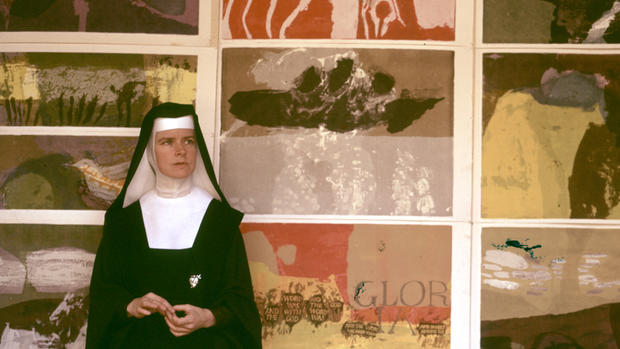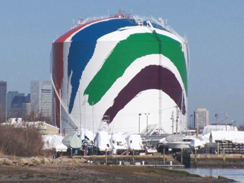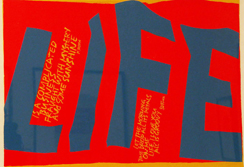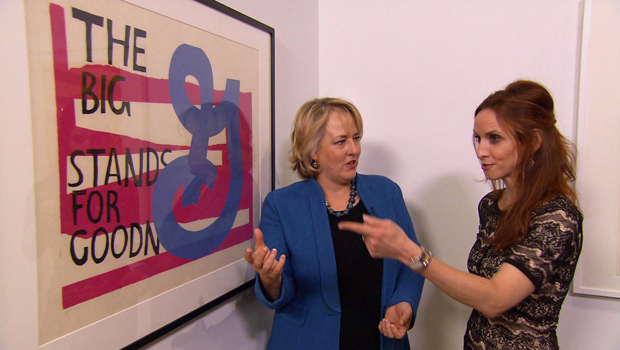Corita Kent: An overshadowed pop art icon
Corita Kent is a name not that well-known outside a small circle of art world admirers. Our Faith Salie reports on an exhibition that is hoping to change that:
It may just be the most famous gas tank in the world. That might not sound like much, but the "Rainbow Swash," as it's called, off Route 93 in Boston, is also one of the largest copyrighted works of art in the world.
Its story goes back to 1971, the height of the Vietnam War, when it was designed as an expression of peace by artist Corita Kent.
Kent also happened to be a nun.
"Corita Kent and the Language of Pop," an exhibit currently on view at the San Antonio Museum of Art, features about 145 works of art by Kent and by her main counterparts in the pop art movement.
Museum director Katie Luber hopes the exhibit places Kent's name firmly alongside her better-known contemporaries.
When asked why Corita Kent isn't a household name, Luber replied, "I think it goes back to the problem that pop art has, in terms of criticism and reception, really been seen as a male-dominated art form. And she is a woman, and she is a nun."
Corita Kent was born Frances Elizabeth Kent in 1918 in Fort Dodge, Iowa. At 18 she entered the order of Sisters of Immaculate Heart of Mary in Los Angeles. She became Sister Mary Corita.
For the next 30 years she would live and work at Immaculate Heart College, eventually heading its art department. During that time she developed her trademark style, combining the written word with silkscreen designs -- an inexpensive medium allowing her to make affordable and accessible art.
"I think a word and image next to it, in the early definition of illustration, to throw light on the form, throws light of the word, and the word throw light on the form, which is a thing that delights me," Kent said in an interview dating from the '60s.
Luber said, "She uses many of the kind of strategies that we see in our really famous and well-known male pop artists, like Warhol and Lichtenstein and Ed Ruscha. She simplifies the images. She makes strong outlines.
"Where she is different from those male artists is that she adds in another textual layer."
Kent used the 1960s' social and cultural revolutions as the catalyst for her messages about hope and love, drawing inspiration from scripture, pop culture and contemporary logos, such as General Mills' "Big G."
"The Big G stands for goodness," reads her 1964 serigraph, "For Eleanor." "It's also one of the best examples for understanding the way that Corita Kent made prints," said Luber. "I mean, this is a very household slogan. But she does subvert it just ever so slightly by not finishing the word 'goodness.'
"You start to meditate on the idea of what G stands for. Is it goodness? Is it good? Is it God? Is it something else?"
Kent also used her work to meditate on a changing Catholic Church. "I think that in the same way that Vatican II loosens up access to religion, Corita wants to loosen up access to art," Luber said.
Her work gained nationwide attention, and in 1967 she graced the cover of Newsweek, with the headline "The Nun: Going Modern."
But perhaps she was TOO modern. According to Ray Smith, the director of the Corita Art Center, an archive of Kent's work in California, "the archdiocese did not like her work. "No, they were not friends," she said. "They really wanted the nuns to be cloistered, and do the service they were supposed to do, and to be good women nuns."
Under pressure, Kent eventually left the order. In 1968 she moved east to Cape Cod, focusing on her art.
She went on to design the 1985 Love Stamp, perhaps her most recognizable work.
A year later, in 1986, Kent died of cancer at age 67.
Whatever legacy she had, began to fade.
"I think it has less to do with the quality or the subject matter, and more to do with the sexism that was part of the art world," said Smith.
Corita Kent's work is peppered with deeper messages, and perhaps her legacy is the same ... waiting to be uncovered.
"These ideas about love and peace and hope are really still messages that people want to hear, that they crave," said Smith. "That's really what she was trying to communicate in her work, and I think that's still as relevant today as it was 40, 50 years ago."
For more info:
- "Corita Kent and the Language of Pop" at the San Antonio Museum of Art (through May 8, 2016)
- Exhibition Catalogue: "Corita Kent and the Language of Pop"
- Corita Art Center, Immaculate Heart High School, Los Angeles
- "Alleluia: The Life and Art of Corita Kent - The '60s" (a film by Thomas Conrad





